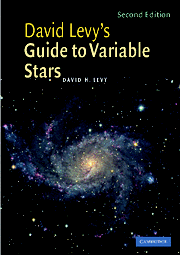Book contents
- Frontmatter
- Contents
- Foreword to the first edition
- Preface
- Acknowledgments
- Part I Getting to know the sky
- Part II Getting to know the variables
- 5 Meeting the family
- 6 Getting started with Cepheids
- 7 Algol, the demon of autumn
- 8 How to estimate a variable
- 9 Names and records
- 10 How your observations help us understand a variable star
- 11 Observing hints
- 12 Observing with CCDs
- 13 Stately and wonderful
- 14 Stars of challenge
- 15 Bright, easy, and interesting
- 16 Betelgeuse: easy and hard
- 17 Not too regular
- 18 Nova? What nova?
- 19 Supernovae
- 20 Clyde Tombaugh's star and the family of cataclysmic variables
- 21 A nova in reverse?
- 22 RU Lupi?
- 23 Orion, the star factory
- 24 Other variable things
- 25 The Sun
- Part III Suggested variables for observation throughout the year
- Part IV A miscellany
- Index
15 - Bright, easy, and interesting
from Part II - Getting to know the variables
Published online by Cambridge University Press: 05 August 2012
- Frontmatter
- Contents
- Foreword to the first edition
- Preface
- Acknowledgments
- Part I Getting to know the sky
- Part II Getting to know the variables
- 5 Meeting the family
- 6 Getting started with Cepheids
- 7 Algol, the demon of autumn
- 8 How to estimate a variable
- 9 Names and records
- 10 How your observations help us understand a variable star
- 11 Observing hints
- 12 Observing with CCDs
- 13 Stately and wonderful
- 14 Stars of challenge
- 15 Bright, easy, and interesting
- 16 Betelgeuse: easy and hard
- 17 Not too regular
- 18 Nova? What nova?
- 19 Supernovae
- 20 Clyde Tombaugh's star and the family of cataclysmic variables
- 21 A nova in reverse?
- 22 RU Lupi?
- 23 Orion, the star factory
- 24 Other variable things
- 25 The Sun
- Part III Suggested variables for observation throughout the year
- Part IV A miscellany
- Index
Summary
With growing experience you can follow several enticing stars throughout their entire range with standard 7 × 50 binoculars. These four stars are easy to find; just use the charts in Figs. 15.1, 15.2, and 15.3.
R Scuti
This most interesting bright variable ranges over about two magnitudes in almost five months. However, it shows many irregularities, and even its period, listed as 140 days, is not precise. Because the inspiring open cluster NGC 6705 (M11) is nearby, R Scuti is as easy to find as it is fun to estimate. The range is large, it is well placed in the sky from May to September, and is a fine example of an easily observed bright variable.
R Scuti is a special type of star, in the RV Tauri class. This star's performance appears to mimic Beta Lyrae, although the period is much, much longer and the maxima are sharper. But RV Tauri stars are not eclipsing binaries. They are very large and luminous yellow supergiant stars that actually pulsate. The shallower of R Scuti's two minima gradually deepens until it becomes the most pronounced low point, and the star now behaves more like a long-period version of Delta Cephei. You should estimate R Scuti once each week.
X Herculis, g Herculis, and RR Coronae Borealis
These are semiregular variables that provide an interesting weekly project (Fig. 15.3).
- Type
- Chapter
- Information
- David Levy's Guide to Variable Stars , pp. 83 - 87Publisher: Cambridge University PressPrint publication year: 2005

